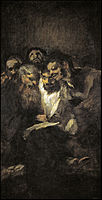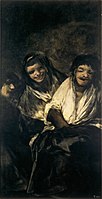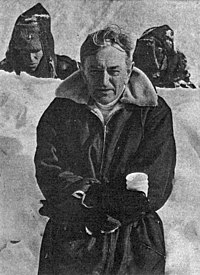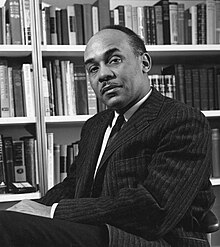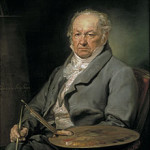 On this day in 1828, romantic painter and printmaker, the last of the Old Masters and the first of the moderns, Francisco Goya died of a stroke at the age of 82 in Bordeaux, France. Born Francisco José de Goya y Lucientes in Fuendetodos, Aragón, Spain, on 30 March 1746. Throughout the Peninsular War, Goya was court painter to the Spanish Crown, remaining in Madrid, where he painted the portrait of Joseph Bonaparte, pretender to the Spanish throne, and documented the war in the masterpiece of studied ambiguity known as the Desastres de la Guerra. Through his works he was both a commentator on and chronicler of his era. The subversive imaginative element in his art, as well as his bold handling of paint, provided a model for the work of artists of later generations. In February 1819, Goya bought a house, called Quinta del Sordo (“Deaf Man’s House”), and painted many unusual paintings on canvas and on the walls, including references to witchcraft and war. One of these is the famous work Saturno devorando a su hijo (Saturn Devouring His Son known informally in some circles as Devoration or Saturn Eats His Child) (see below), which displays a Greco-Roman mythological scene of the god Saturn consuming a child, possibly a reference to Spain’s ongoing civil conflicts. The series has been described as essential to our understanding of the human condition in modern times, just as Michelangelo’s Sistine ceiling is essential to understanding the tenor of the 16th century. At the age of 75, alone and in mental and physical despair, he completed the work as one of his 14, or possibly 15, Black Paintings, all of which were executed in oil directly onto the plaster walls of his house. Goya did not intend for the paintings to be exhibited and did not write of them. It was not until around 1874, 46 years after his death, that they were taken down and transferred to a canvas support. Many of the works apparently were significantly altered during the restoration, and what remain are has been described as crude facsimiles of what Goya painted. The effects of time on the murals, coupled with the inevitable damage caused by the delicate operation of mounting the crumbling plaster on canvas, meant that most of the murals suffered extensive damage and loss of paint. Today they are on permanent display at the Museo del Prado, Madrid.
On this day in 1828, romantic painter and printmaker, the last of the Old Masters and the first of the moderns, Francisco Goya died of a stroke at the age of 82 in Bordeaux, France. Born Francisco José de Goya y Lucientes in Fuendetodos, Aragón, Spain, on 30 March 1746. Throughout the Peninsular War, Goya was court painter to the Spanish Crown, remaining in Madrid, where he painted the portrait of Joseph Bonaparte, pretender to the Spanish throne, and documented the war in the masterpiece of studied ambiguity known as the Desastres de la Guerra. Through his works he was both a commentator on and chronicler of his era. The subversive imaginative element in his art, as well as his bold handling of paint, provided a model for the work of artists of later generations. In February 1819, Goya bought a house, called Quinta del Sordo (“Deaf Man’s House”), and painted many unusual paintings on canvas and on the walls, including references to witchcraft and war. One of these is the famous work Saturno devorando a su hijo (Saturn Devouring His Son known informally in some circles as Devoration or Saturn Eats His Child) (see below), which displays a Greco-Roman mythological scene of the god Saturn consuming a child, possibly a reference to Spain’s ongoing civil conflicts. The series has been described as essential to our understanding of the human condition in modern times, just as Michelangelo’s Sistine ceiling is essential to understanding the tenor of the 16th century. At the age of 75, alone and in mental and physical despair, he completed the work as one of his 14, or possibly 15, Black Paintings, all of which were executed in oil directly onto the plaster walls of his house. Goya did not intend for the paintings to be exhibited and did not write of them. It was not until around 1874, 46 years after his death, that they were taken down and transferred to a canvas support. Many of the works apparently were significantly altered during the restoration, and what remain are has been described as crude facsimiles of what Goya painted. The effects of time on the murals, coupled with the inevitable damage caused by the delicate operation of mounting the crumbling plaster on canvas, meant that most of the murals suffered extensive damage and loss of paint. Today they are on permanent display at the Museo del Prado, Madrid.
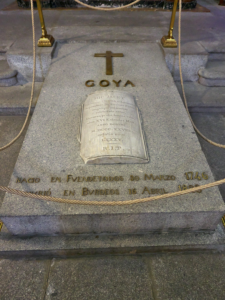 The Final Footprint – Goya was initially interred in Bordeaux. In 1919 his remains were transferred to the Real Ermita de San Antonio de la Florida in Madrid. However, the skull was missing, a detail the Spanish consul immediately communicated to his superiors in Madrid, who wired back, “Send Goya, with or without head.” The chapel ceiling and dome frescoes were painted by Goya. In the Oliver Stone film, Wall Street: Money Never Sleeps, Goya’s Saturno devorando a su hijo hangs in the office of Bretton James (Josh Brolin). James states that this is the 15th Black Painting and that the other 14 are in the Museo del Prado. Actually, it appears there may be a 15th Black Painting; Heads in a Landscape (Cabezas en un paisaje) (see below). It may have became separated from the other paintings in the collection and is now in the collection of poet, publisher and art dealer Stanley Moss in New York.
The Final Footprint – Goya was initially interred in Bordeaux. In 1919 his remains were transferred to the Real Ermita de San Antonio de la Florida in Madrid. However, the skull was missing, a detail the Spanish consul immediately communicated to his superiors in Madrid, who wired back, “Send Goya, with or without head.” The chapel ceiling and dome frescoes were painted by Goya. In the Oliver Stone film, Wall Street: Money Never Sleeps, Goya’s Saturno devorando a su hijo hangs in the office of Bretton James (Josh Brolin). James states that this is the 15th Black Painting and that the other 14 are in the Museo del Prado. Actually, it appears there may be a 15th Black Painting; Heads in a Landscape (Cabezas en un paisaje) (see below). It may have became separated from the other paintings in the collection and is now in the collection of poet, publisher and art dealer Stanley Moss in New York.
Images of the Black Paintings
|
#RIP #OTD in 1850 French artist known for her wax sculptures and Madame Tussauds, the wax museum she founded in London, Marie Tussaud died in her sleep in London, aged of 88. Memorial tablet on the right side of the nave of St. Mary’s Roman Catholic Church, Cadogan Street, London
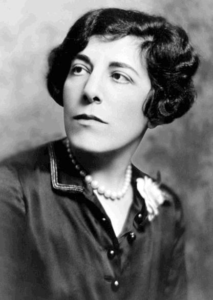 On this day in 1968, Pulitzer Prize-winning novelist, short story writer and playwright, Edna Ferber died from stomach cancer in New York City at the age of 82. Born on 15 August 1885 in Kalamazoo, Michigan. She was awarded the Pulitzer for her book So Big (1924). Her novel Show Boat (1926) was made into a Broadway play with music by Jerome Kern and Oscar Hammerstein II. The book was also made into three films. The 1951 version starred Kathryn Grayson, Ava Gardner, and Howard Keel. And of course, she wrote the novel, Giant (1952), the epic story of the Benedict family and their Reata Ranch in Texas. The book was made into a Hollywood classic in 1956 starring; Elizabeth Taylor (Leslie Lynnton Benedict), Rock Hudson (Jordan “Bick” Benedict, Jr.) and James Dean (Jett Rink) and featuring Carroll Baker (Luz Benedict, Leslie and Bick’s daughter), Jane Withers, Chill Wills, Mercedes McCambridge (Luz Benedict, Bick’s sister), Dennis Hopper (Jordan “Jordy” Benedict III), Sal Mineo, Rod Taylor and Earl Holliman. Giant was the last of Dean’s three films as a leading actor, and earned him his second and last Academy Award nomination; he was killed in a car accident before the film was released. The book and the movie are perhaps my very favorites. Feber never married. In her early novel Dawn O’Hara (1911), the title character’s aunt is said to have remarked, “Being an old maid was a great deal like death by drowning — a really delightful sensation when you ceased struggling.”
On this day in 1968, Pulitzer Prize-winning novelist, short story writer and playwright, Edna Ferber died from stomach cancer in New York City at the age of 82. Born on 15 August 1885 in Kalamazoo, Michigan. She was awarded the Pulitzer for her book So Big (1924). Her novel Show Boat (1926) was made into a Broadway play with music by Jerome Kern and Oscar Hammerstein II. The book was also made into three films. The 1951 version starred Kathryn Grayson, Ava Gardner, and Howard Keel. And of course, she wrote the novel, Giant (1952), the epic story of the Benedict family and their Reata Ranch in Texas. The book was made into a Hollywood classic in 1956 starring; Elizabeth Taylor (Leslie Lynnton Benedict), Rock Hudson (Jordan “Bick” Benedict, Jr.) and James Dean (Jett Rink) and featuring Carroll Baker (Luz Benedict, Leslie and Bick’s daughter), Jane Withers, Chill Wills, Mercedes McCambridge (Luz Benedict, Bick’s sister), Dennis Hopper (Jordan “Jordy” Benedict III), Sal Mineo, Rod Taylor and Earl Holliman. Giant was the last of Dean’s three films as a leading actor, and earned him his second and last Academy Award nomination; he was killed in a car accident before the film was released. The book and the movie are perhaps my very favorites. Feber never married. In her early novel Dawn O’Hara (1911), the title character’s aunt is said to have remarked, “Being an old maid was a great deal like death by drowning — a really delightful sensation when you ceased struggling.”
 The Final Footprint – Feber was cremated. A plaque was placed in her honour in Manhattan on the building at 65th Street and Central Park West where she lived for six years. The plaque reads; “The widely-read novelist, short story writer, and playwright, best known for the novel Giant (1952), lived here from 1923 to 1929. Ferber’s fiction is distinquished by larger-than-life stories, strong female characters, and distinctive renderings of Amercian settings. Two of her novels were published while she lived here: the Pulitzer Prize-winning So Big (1924), and Show Boat (1926).”
The Final Footprint – Feber was cremated. A plaque was placed in her honour in Manhattan on the building at 65th Street and Central Park West where she lived for six years. The plaque reads; “The widely-read novelist, short story writer, and playwright, best known for the novel Giant (1952), lived here from 1923 to 1929. Ferber’s fiction is distinquished by larger-than-life stories, strong female characters, and distinctive renderings of Amercian settings. Two of her novels were published while she lived here: the Pulitzer Prize-winning So Big (1924), and Show Boat (1926).”
| Sir David Lean CBE |
|
|---|---|
 |
|
On this day in 1991, film director, producer, screenwriter and editor David Lean died In Limehouse, London at the age of 83. Born on 25 March 1908 in Croydon, Surrey, England, United Kingdom. Lean was responsible for large-scale epics such as The Bridge on the River Kwai (1957), Lawrence of Arabia (1962) and Doctor Zhivago (1965). He also directed adaptations of Charles Dickens novels Great Expectations (1946) and Oliver Twist (1948), as well as the romantic drama Brief Encounter (1945).
Originally starting out as a film editor in the early 1930s, Lean made his directorial debut with 1942’s In Which We Serve, which was the first of four collaborations with Noël Coward. Beginning with Summertime in 1955, Lean began to make internationally co-produced films financed by the big Hollywood studios. In 1970 the critical failure of his film Ryan’s Daughter led him to take a fourteen-year break from film making, during which he planned a number of film projects which never came to fruition. In 1984 he had a career revival with A Passage to India, adapted from E. M. Forster‘s novel; it was an instant hit with critics but proved to be the last film Lean would direct.
Nominated seven times for the Academy Award for Best Director, which he won twice for The Bridge on the River Kwai and Lawrence of Arabia, he has seven films in the British Film Institute’s Top 100 British Films (with three of them being in the top five) and was awarded the AFI Life Achievement Award in 1990.
Lean was married six times and was divorced five times. He was survived by his last wife, art dealer Sandra Cooke, the co-author (with Barry Chattington) of David Lean: An Intimate Portrait. His six wives were:
- Isabel Lean (28 June 1930 – 1936) (his first cousin)
- Kay Walsh (23 November 1940 – 1949)
- Ann Todd (21 May 1949 – 1957)
- Leila Matkar (4 July 1960 – 1978) (From, Hyderabad, India). Lean’s longest-lasting marriage.
- Sandra Hotz (28 October 1981 – 1984)
- Sandra Cooke (15 December 1990 – 16 April 1991)
The Final Footprint
Lean was cremated at Putney Vale Cemetery and Crematorium, Wimbledon.
| Ralph Ellison | |
|---|---|
On this day in 1994 novelist, literary critic and scholar Ralph Ellison died from pancreatic cancer in New York City at the age of 81. Born Ralph Waldo Ellison on March 1, 1913 in Oklahoma City, Oklahoma. Perhaps best known for his novel Invisible Man, which won the National Book Award in 1953. He also wrote Shadow and Act (1964), a collection of political, social and critical essays, and Going to the Territory (1986). A posthumous novel, Juneteenth, was published after being assembled from voluminous notes he left after his death.
In 1938 Ellison met Rosa Araminta Poindexter, a woman two years his senior. They were married in late 1938. Rose was a stage actress, and continued her career after their marriage. In biographer Arnold Rampersad’s assessment of Ellison’s taste in women, he was searching for one “physically attractive and smart who would love, honor, and obey him–but not challenge his intellect.” At first they lived at 312 West 122nd Street, Rose’s apartment, but moved to 453 West 140th Street after her income shrank. In 1941 he briefly had an affair with Sanora Babb, which he confessed to his wife afterward, and in 1943 the marriage was over.
Published in 1952, Invisible Man explores the theme of man’s search for his identity and place in society, as seen from the perspective of the first-person narrator, an unnamed African American man in the New York City of the 1930s. In contrast to his contemporaries such as Richard Wright and James Baldwin, Ellison created characters that are dispassionate, educated, articulate, and self-aware. Through the protagonist, Ellison explores the contrasts between the Northern and Southern varieties of racism and their alienating effect. The narrator is “invisible” in a figurative sense, in that “people refuse to see” him, and also experiences a kind of dissociation. The novel also contains taboo issues such as incest and the controversial subject of communism.
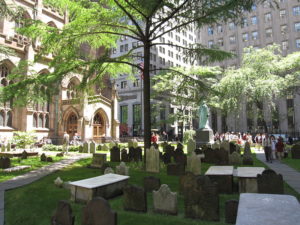 The Final Footprint
The Final Footprint
Ellison was entombed at Trinity Church Cemetery and Mausoleum in the Washington Heights neighborhood of Upper Manhattan.
| Robert Urich | |
|---|---|
On this day in 2002, actor Robert Urich died at Los Robles Hospital & Medical Center in Thousand Oaks, California at the age of 55 from synovial sarcoma. Born Robert Michael Urich on December 19, 1946 in Toronto, Ohio. Over the course of his 30-year career, he starred in 15 television series. Perhaps best know for his role as Jake Spoon in the television mini-series adaptation of Larry McMurtry’s Lonesome Dove.
Urich began his career in television in the early 1970s. After guest stints and roles in short-lived television series, he won a co starring role in the action/crime drama series S.W.A.T. in 1975. In 1976, he landed the role of Dan Tanna in the crime drama series Vega$. It aired on ABC from 1978 to 1981, and earned him two Golden Globe Award nominations. In addition to his work in television, he also starred in several feature films, including Magnum Force (1973), The Ice Pirates (1984), and Turk 182 (1985). From 1985 to 1988, he portrayed the title role in the detective television series Spenser: For Hire, based on Robert B. Parker’s popular series of mystery novels. In 1988, he began hosting the documentary series National Geographic Explorer. He won a CableACE Award for his work on the series. He was also awarded a Golden Boot Award for his work in Western television series and films.
In 1996, Urich starred in The Lazarus Man. It was canceled shortly after he announced that he had been diagnosed with synovial sarcoma, a rare cancer, in July 1996. He sought treatment for his illness while continuing his career and also worked to raise money for cancer research. He was declared cancer free in 1998 and returned to television in the UPN series, Love Boat: The Next Wave. In 2000, he made his Broadway debut as Billy Flynn in the musical Chicago. His last role was in the NBC sitcom Emeril in 2001, but in the autumn of that year, his cancer returned.
Urich’s first marriage was to actress Barbara Rucker in 1968. They divorced in 1974. He married actress Heather Menzies in 1975. They remained married until his death.
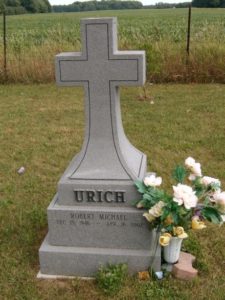 The Final Footprint
The Final Footprint
His Funeral Mass was offered on April 19 at St. Charles Borromeo Church in North Hollywood. He was cremated and his ashes were interred on the grounds of his family’s vacation home in Prince Edward County, Ontario, Canada. A monument was placed in the West Lake Church of Christ Cemetery, which is located near the family’s vacation home.
Have you planned yours yet?
Follow TFF on twitter @RIPTFF




